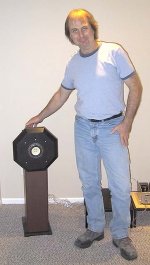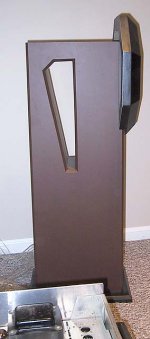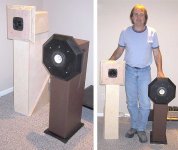chrisb said:
Well, this could certainly turn out to be a "foot in mouth" remark - I'll be able to try a quick audition only test in the next day or so.
My comment was based on the significant difference between the T/S parameters and rising frequency response above 150Hz in Fostex's published specs.
For a fact, the basket frame size is identical for the 2 drivers and the 127's magnet assembly is much (26.3mm) narrower and only slightly (4mm) deeper, so except in cases where cabinet includes bracing tightly wrapping the magnet structure, there's no reason at all that they shouldn't be "interchangeable"
For that matter, if I get around to swapping drivers out, I may as well try the 126's in the Fonken aperiodically vented boxes.
Care to make any predictions on subjective performance ( I don't have access to any measuring kit )
Looked at the Fonken pretty nice I figure..
I like to know how this 127 BLH thing works out to see how bad of an idea it is.
Gex
Greets!
ML's formulas are only for max gain/BW compression loaded horns, so to reactance annull a BLH, the theoretically ideal alignments per published specs only are:
FE126E:
Fl = 9.45 Hz
Fh = 518.52 Hz
Vf = 5.305"^3
St = 5.305"^2
M = 0.505
FE127E:
Fl = 17.5 Hz
Fh = 280 Hz
Vf = 22.703"^3
St = 9.189"^2
M = 0.538
These are impractical alignments for the casual DIYer since even if truncated at a higher frequency they will be exceedingly long to get to the minimum mouth area and will have way too much gain to blend to the driver's direct radiation without some form of EQ to shape the in-room response. These also show why the 127 is ill suited for use in the 126's horn, while the 126's effective Qts could be raised to 'fit' in the 127's horn.
Once you move away from these alignments, ML's math breaks down since there's no longer a compression chamber to balance out the horn's acoustic loading, especially when trying to accurately calc the big vent BR style of BLH that's required.
GM
ML's formulas are only for max gain/BW compression loaded horns, so to reactance annull a BLH, the theoretically ideal alignments per published specs only are:
FE126E:
Fl = 9.45 Hz
Fh = 518.52 Hz
Vf = 5.305"^3
St = 5.305"^2
M = 0.505
FE127E:
Fl = 17.5 Hz
Fh = 280 Hz
Vf = 22.703"^3
St = 9.189"^2
M = 0.538
These are impractical alignments for the casual DIYer since even if truncated at a higher frequency they will be exceedingly long to get to the minimum mouth area and will have way too much gain to blend to the driver's direct radiation without some form of EQ to shape the in-room response. These also show why the 127 is ill suited for use in the 126's horn, while the 126's effective Qts could be raised to 'fit' in the 127's horn.
Once you move away from these alignments, ML's math breaks down since there's no longer a compression chamber to balance out the horn's acoustic loading, especially when trying to accurately calc the big vent BR style of BLH that's required.
GM
planet10 said:
Did you make a spreadsheet?
I'd be interested in what it spits out for the FE108eS,
Ron Clarke is working on a deflector for the back to aid wall loading (think of it as a mouth extensions)
dave
Naw, I did it the old fashioned way. On paper. I think I will try it all again. Maybe this time I will do a spreadsheet. ML is supposed to do the same thing though I have not tried it yet. Maybe I will give that a try as well.
I will try the 108 es as well.
I can't wait to see what Ron comes up with for the back extensions.
chrisb said:
Well, this could certainly turn out to be a "foot in mouth" remark - I'll be able to try a quick audition only test in the next day or so.
My comment was based on the significant difference between the T/S parameters and rising frequency response above 150Hz in Fostex's published specs.
For a fact, the basket frame size is identical for the 2 drivers and the 127's magnet assembly is much (26.3mm) narrower and only slightly (4mm) deeper, so except in cases where cabinet includes bracing tightly wrapping the magnet structure, there's no reason at all that they shouldn't be "interchangeable"
For that matter, if I get around to swapping drivers out, I may as well try the 126's in the Fonken aperiodically vented boxes.
Care to make any predictions on subjective performance ( I don't have access to any measuring kit )
I don't know if you remember that I put the 126s in the FOnken boxes. SOund was good but very little low end. I put those modded Pioneer A11EC80's in them now and I am working out as many tweeks on these drivers as possible (they don't really represent what the factory sent(which was awful). They are beginning to sound quite nice. In fact, I would say they sound pretty spectacular for an 11 dollar driver. I am going to post more listening impressions as I work through everything I am doing an d the effects they are having on the sound.
I am finally ordering my FE127's this weekend. I can't wait to see what they sound like in the Fonken boxes.
GM said:Greets!
ML's formulas are only for max gain/BW compression loaded horns, so to reactance annull a BLH, the theoretically ideal alignments per published specs only are:
FE126E:
Fl = 9.45 Hz
Fh = 518.52 Hz
Vf = 5.305"^3
St = 5.305"^2
M = 0.505
FE127E:
Fl = 17.5 Hz
Fh = 280 Hz
Vf = 22.703"^3
St = 9.189"^2
M = 0.538
These are impractical alignments for the casual DIYer since even if truncated at a higher frequency they will be exceedingly long to get to the minimum mouth area and will have way too much gain to blend to the driver's direct radiation without some form of EQ to shape the in-room response. These also show why the 127 is ill suited for use in the 126's horn, while the 126's effective Qts could be raised to 'fit' in the 127's horn.
Once you move away from these alignments, ML's math breaks down since there's no longer a compression chamber to balance out the horn's acoustic loading, especially when trying to accurately calc the big vent BR style of BLH that's required.
GM
Please expand upon what you are saying. Isn't the gain of the horn decided by the length and particular curvature or flare (exponential vs. hyperbolic vs. Tractrix) of the horn? If you want to cut back the output of the horn for a given situation you would simply change the allignment of the calculations, ex. calculate the length and flare for different situations such as placement against a wall or in a corner? With Leach's formulas you are able to take these things in to account. The COupling chamber is also taken into account with Leach if you want it to be. Now, correct me if I am wrong, but, the calculations begin with Throat. then move to mouth, then length, then CC. CC being the last thing calculated and therefore somewhat independent of the other variables and only used to create an upper level cutoff. For example, I calced my CC to cut off at 300 Hz. Now, as per the formulas I came up with a 3 liter CC. This combined with a 140 cm2 throat (in theory) should creat the ideal situation for the beginning of a horn. Now, this is where Leach falls apart for me. My throat areas don't match what I have seen and built myself in to the horns that I have experience with. Am I missing something here?
Greets!
Hmm, not sure how to 'expand' on what I said. Yes, it's true that different flare factors have different gain ratios, but without a compression chamber, the horn's gain is compromised. Since we don't want a lot of gain in a BLH loaded with a 'fullrange' driver, this isn't a big deal, but ML's math doesn't work for calcing one other than the one alignment I listed since it always assumes/calcs a compression chamber for a higher Fl.
Without a CC, the filter chamber (which now is nothing more than a BR alignment), sets the BW, with the horn vent setting its gain profile.
None of this means you can't use ML to design one, just you have to take the one ideal alignment and adapt it to your needs by finding the right section along its length to use. What you wind up with is a long, ~conical expansion that requires very careful folding, so you're better off using a higher effective Qts to lower Fh to keep it as short as practical.
GM
Hmm, not sure how to 'expand' on what I said. Yes, it's true that different flare factors have different gain ratios, but without a compression chamber, the horn's gain is compromised. Since we don't want a lot of gain in a BLH loaded with a 'fullrange' driver, this isn't a big deal, but ML's math doesn't work for calcing one other than the one alignment I listed since it always assumes/calcs a compression chamber for a higher Fl.
Without a CC, the filter chamber (which now is nothing more than a BR alignment), sets the BW, with the horn vent setting its gain profile.
None of this means you can't use ML to design one, just you have to take the one ideal alignment and adapt it to your needs by finding the right section along its length to use. What you wind up with is a long, ~conical expansion that requires very careful folding, so you're better off using a higher effective Qts to lower Fh to keep it as short as practical.
GM
Please tell me this thread isnt dying ! I really want to build these and I hope the final design is coming about soon....... 

I'll bet a number of these horns are in the works, I know mine are.
The idea is, we're all part of the design team. Build 'em and post your findings! Don
The idea is, we're all part of the design team. Build 'em and post your findings! Don
The frugel-horns are slowly progressing. The next iteration is gesting in my head, CAD program & spreadsheet. Martin & Ron have been quiet of late, but they are at least as busy as i am.
We can say that the alpha 1.3.0 horn is a decent sounding build, the next iteration will be quite a bit different (and hopefully won't fall flat on its face). We have found that the current drawings work at 130mm and 140 mm wide inside (Martin says they don't model significantly different). Here are pics of a 140mm wide version with octagonal supra-baffle -- we've also tried square, and when i get to it, a star shaped one is just too intriging to pass up....
dave
We can say that the alpha 1.3.0 horn is a decent sounding build, the next iteration will be quite a bit different (and hopefully won't fall flat on its face). We have found that the current drawings work at 130mm and 140 mm wide inside (Martin says they don't model significantly different). Here are pics of a 140mm wide version with octagonal supra-baffle -- we've also tried square, and when i get to it, a star shaped one is just too intriging to pass up....
dave
Attachments
Our reference is still the RonHorn A126, but in the room we set up for Frugel-Horn development they tend to overload the room, and the Frugel-Horns -- even at this early stage -- come close.
In this size comparo, one can see why WAF (and a set of corners) might dictate the Frugel-Horn over the A126.
In this size comparo, one can see why WAF (and a set of corners) might dictate the Frugel-Horn over the A126.
Attachments
doorman said:Is the "big stop-sign" laminated mdf?
Plywood -- the supra-baffles are where i think we can see some creativity expressed.
dave
Now who's that handsome dude standing beside some very nice sounding speakers?, why it's me lol!!!
Many thanks to Dave and Chris for letting me come by and have a listen 🙂 . First off I'd just like to comment that I'm new to the fullrange single driver sound, I have a pair of fe108ez's that I bought but have yet to build a home for them. The sound of both the Frugels and the A126 horn was to me, amazing. I wish I could still be in the room listening and exploring the sound more but mostly just having fun enjoying the music. Between the 108 and 126 driver I prefer the 108 in both horns, but the 126 sounds really really nice also. It was such a great experience for me to be able to hear these wonderful creations and meet Chris for the first time and see Dave again. Dave🙂
Many thanks to Dave and Chris for letting me come by and have a listen 🙂 . First off I'd just like to comment that I'm new to the fullrange single driver sound, I have a pair of fe108ez's that I bought but have yet to build a home for them. The sound of both the Frugels and the A126 horn was to me, amazing. I wish I could still be in the room listening and exploring the sound more but mostly just having fun enjoying the music. Between the 108 and 126 driver I prefer the 108 in both horns, but the 126 sounds really really nice also. It was such a great experience for me to be able to hear these wonderful creations and meet Chris for the first time and see Dave again. Dave🙂
greetings peoples, good to see the developments of the frugal horns, well done fellas.Dave looks like one of those models fondelling the prizes on sale of the century, although if hes going to make it past the first interview I'd suggest a gold glowmesh number! Good luck with the developments
cheers fergs
cheers fergs
Thanks for all your hard work all.
I cannot believe how small they are. The stop sign makes that much of a differance? it kinda kills the WAF but adds a DIY tweak feel and sure to create comments from the average joe.
I cannot believe how small they are. The stop sign makes that much of a differance? it kinda kills the WAF but adds a DIY tweak feel and sure to create comments from the average joe.
gexter said:Thanks for all your hard work all.
I cannot believe how small they are. The stop sign makes that much of a differance? it kinda kills the WAF but adds a DIY tweak feel and sure to create comments from the average joe.
Gex - it doesn't need to be octagonal ( I was just feeling creative that day) - in fact square or a GR rectangle would probably give better results. Yes it seems to help quite a bit filling in the gap between the baffle step frequency roll-off and the low end horn/room lift
As an aside, note that Ron C has commented recently on the Fullrange forum the purpose of the prism shaped deflectors he's incorporated in his A126 design."
The deflectors make no difference in this application as the primary reason behind the deflectors is to keep a reflected energy from returning back to the mouth which will cause extreem ripples in the FR curve (we have enough of those anyway). Any rear firing horn which is tight to a wall,or worse a corner, will reflect a great deal of energy back to the mouth, which returns up the flare and ends up fighting with the either positive or negative pressure along the trip back to the filter chamber. Thus the deflectors.
I hope not to misquote him, but it's interesting to note that he describes corner loading of rear firing horn as "worse" case in terms of potential interference by refelected energy within the horn enclosure.
- Home
- Loudspeakers
- Full Range
- The Frugel-Horn Project




